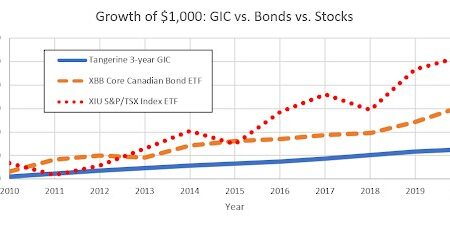Pension Basics: The Commuted Value
If your employer provides you with a defined benefit (DB) pension consider yourself lucky. According a 2009 study by Statistics Canada, fewer Canadian employees are covered by DB plans today. In 1991 41 per cent of Canadians were covered by DB, while in 2006 only 30 per cent of employees were covered. If you have a DB plan you’ve probably heard of the commuted value (CV), but do you really understand it? Let’s explore the CV and the various options available to you if you terminate your employment.
What is the commuted value?
The CV is a lump sum payment representing the present value of a member’s accrued pension. In layman’s terms, the CV represents how much money you would have to invest today to pay your future monthly pension. The CV goes by many names: transfer value, lump sum value, and actuarial present value.
Here is the basic formula for calculating the CV in a DB pension:
Your monthly accrued pension times 12 times the annuity factor.
While your monthly pension is easy to figure out (you can check on your annual pension statement), the annuity factor is very complicated – it’s based on the interest rate in effect, the age of the employee and various actuarial assumptions. The CV isn’t just something you can calculate yourself – you’ll need to speak with your employer or pension administrator to determine it.
What affects the value of my commuted value?
Besides your accrued pension, two of the major factors that determine your CV are your age and the interest rates currently in effect. There is a direct relationship between your age and the CV: the older you are, the higher the CV (even for a younger employee with the same accrued pension as an older worker). The logic behind this involves the time value of money. While the younger employee has more time to invest the money and realize the power of compound interest, the older employee is closer to retirement and thus has less time to invest the lump sum.
Besides your age, the interest rates currently in effect have an impact on the CV. There is an indirect relationship between the CV and interest rates: the higher the interest rates the lower the CV and vice-versa. This again has to do with time value of money – if you were to invest a lower amount you would need a higher interest rate to end up with the same retirement savings as investing a higher amount with a lower interest rate. Unfortunately you don’t have any control over interest rates, but it’s handy to know in case you decide to terminate your employment and transfer your CV.
Deferred Pension or Commuted Value?
Employees who leave their job prior to retirement are faced with a tough decision: should they elect a deferred pension or the CV? Before making this important financial decision it’s a good idea to consult a financial advisor since either decision can have a major financial impact on your retirement. Both options have their risks and rewards.
With a deferred pension you essentially leave your accrued pension with your employer until you are eligible for retirement; this can be a good thing since your pension is safe with your employer and will be paid out as a monthly pension when you opt to retire. However, some disadvantages are that your pension won’t grow and your money remains with your employer, so it could be at risk if something were to happen to your employer.
The other option is transferring the commuted value to a locked-in RRSP or retirement vehicle. The major advantage is the CV provides greater financial control over your retirement savings. You can invest your money and realize a decent return. Unfortunately there’s a risk – since you’re investing your retirement savings they aren’t guaranteed, so you could potentially lose a substantial amount of your retirement nest egg. Another disadvantage may be that employees who elect the CV won’t be eligible for post-retirement benefits, such as health and dental coverage (although most employers are doing away with them to save on costs).
Final Thoughts
Hopefully you’ve gained a better understanding of the CV. As I’ve mentioned, it’s very complicated to calculate and a very major financial decision whether to terminate your employment and take the CV or take a deferred pension. Be sure to think long and carefully about it and consult your financial advisor.
About the Author: Sean Cooper is a single, 20-something year old, first time home buyer located in Toronto. He has experience in the financial sector as a Pension Analyst, RESP administrator and Income Tax Preparer. He holds a Bachelor of Commerce in business management from Ryerson University.










What interest rate would be used today to calculate the commuted vale of a DB plan. April 2020
For instance ten year gov bonds are.6 percent. 30 year Canadas are under 2 percent.
Jack E
Hi,
Before I attain 55 I will have 31 years service with a DB pland annual salary will have averaged around 65000 during the pass 5 years, is the CV advisable in my case? I am single and would like to be able to use some money maybe to even purchase a home outright. Not sure what to do.
Any advice would be great.
The factors that need to be considered include:
1. The client’s and partner’s age, net worth, other assets and debts and other sources of income;
2. The client’s tolerance for risk;
3. Assumptions on inflation and interest rates;
4. Whether the pension is actuarially reduced if payments start prior to normal retirement;
5. Whether pension income is reduced after age 65 based on CPP/QPP integration;
6. Whether the pension income is indexed;
7. The survivor benefit under the pension;
8. Whether the client retains coverage under other benefit programs if the pension option is not chosen and the cost of purchasing this coverage;
9. The amount of the tax payable on the commuted value if the transfer option is chosen;
10. Whether the client requires an estate value after the death of the client and surviving spouse; or whether there are other individuals who are dependent on the client and the client’s health status.
Each of these factors may be an advantage or a disadvantage to a pension transfer, depending on the client’s circumstances. It is the combined effect of all factors that determines overall what option is in the client’s best interests.
The explanation is all wrong. My commuted valued continues to go lower as I get older. I can retire at 55 and since I am older than that , less money is needed in my commuted value to pay my pension when I actually do retire. Then there is the capitalized value of the pension for divorce and then each province has it’s own rules and federal pensions have different rules. It is all wrong, don’t believe what you read here. Hire an Actuary.
Oh and the one thing I agree on is that a DB Plan may not be there in the future. I don’t count that in my retirement plans and assume that money does not exist. The only thing I may count on is my contributions and nothing more.
Therefore, part of my monthly budget is to have a minimum amount of savings a month (about 3-5 times what I contribute to my plan) per month and doing my own investing outside my pension plan.
I’m just thankful to have a pension fund. Many workers today will never have such benefits and younger workers need to invest in RRSPs early and often – they should not count on anyone else to plan for their retirement but themselves.
As a young “20something” teacher, I am one of the few who don’t like the DB plan. I would much rather have a defined contribution plan. My pension fund is massive and has a difficult time returning market averages. I believe I would be much further ahead if I took my money, and what the government (my employer) are already putting in the pot, and investing it myself.
The other thing I have to take into consideration is that I’m fairly certain I don’t want to be a teacher for a full thirty years. I thrive on change and new challenges; therefore, I would prefer to be able to take my defined contribution plan with me when I go, quickly and easily. This is often extremely difficult to do with the bureaucratic nightmare that is a defined benefit plan. At the end of the day, I’m fairly certain something will be left for me, but I would feel much more secure with my money in my own account and away from the hands of an ageing group of babyboomers who may outlive their own contributions and start eating into mine!
Just a slight tangent. The underlying concern most people have is running out of money. DB’s sound great because that shouldn’t happen – but as noted, if the plan goes under then you’re really screwed.
Manulife has done some math around the idea of balancing risk vs. running out of money. I believe they created a structure similiar to asset allocation, but doing investment allocation instead – balancing long term guarantees with risk and return. I didn’t take notes during the presenation so I’m no expert, however if you want to see some actual calculated strategy around ensuring you don’t run out of money in retirement, I’d suggest Manulife is one place to investigate. Frankly I was impressed simply with the fact that they’ve done some research and backed it up with some probability and statistics rather than marketing.
Like Manulife did with the Guaranteed Income Funds with Guaranteed Withdrawal Benefit and Death Benefits that almost bankrupted them, and why most other insurers do not offer them anymore!! ??
I would also question the validity of the commerce profs at Ryerson.
The good thing is that he is “20something” and obviously willing to learn, and learn about all the dry stuff the 60somethings who can’t retire should have spent some time learning when they were his age.
The bad thing is that learning usually involves mistakes, and to publish mistakes that others may apply to their own lives is not good. But you do get what you pay for, and all the info on this site is free, after all…
He is, however, willing to put his neck out and write these articles for which he may or may not receive an inordinate amount of flack (not AFLAC!, just flack), which is more than most of us would care to do lest the same happens to us!
Besides, all this pension stuff just might be moot if things keep going the way they have been. ;)
Steve,
This is the same guy who advised artificially inflating income for the purpose of qualifying for a higher mortgage amount. After that advice I would take everything he says with a grain of salt. He’s also 20something so definitely lacks the anecdotal experience to handle any kind of advice. There you have it…
Can we just bother our employer’s HR department to get an estimate of our current CV? I ask because the first time I applied for a mortgage (when I had very limited assets), the banker put a blue-sky estimate of my pension’s value into her calculations to make me look better. It would be nice to have a real number for that (although now that my financial situation has improved, they don’t seem to care about that number as much!).